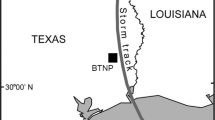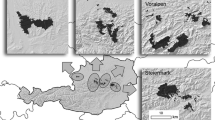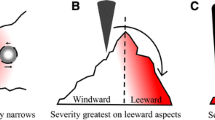Abstract
Context
The southeastern U.S. experiences tornadoes and severe thunderstorms that can economic and ecological damages to forest stands resulting in loss of timber, reduction in short-term carbon sequestration, and increased susceptibility to forest pests and pathogens.
Objectives
This project sought to determine landscape-scale patterns of recurring wind damages and their relationships to topographic attributes, overall climatic patterns and soil characteristics in southeastern forests.
Methods
We assembled post-damage assessment data collected since 2012 by the National Oceanic and Atmospheric Administration (NOAA). We utilized a regularized Generalized Additive Model (GAM) framework to identify and select influencing topographic, soil and climate variables and to discriminate between damage levels (broken branches, uprooting, or trunk breakage). Further, we applied a multinomial GAM utilizing the identified variables to generate predictions and interpolated the results to create predictive maps for tree damage.
Results
Terrain characteristics of slope and valley depth, soil characteristics including erodibility factor and bedrock depth, and climatic variables including temperatures and precipitation levels contributed to damage severity for pine trees. In contrast, valley depth and soil pH, along with climactic variables of isothermality and temperature contributed to damage severity for hardwood trees. Areas in the mid-south from Mississippi to Alabama, and portions of central Arkansas and Oklahoma showed increased probabilities of more severe levels of tree damage.
Conclusions
Our project identified important soil and climatic predictors of tree damage levels, and areas in the southeastern U.S. that are at greater risk of severe wind damage, with management implications under continuing climate change.









Similar content being viewed by others
Data availability
The datasets compiled and analyzed during the current study are available from sources indicated within the manuscript or from the corresponding author on reasonable request.
References
Allen MS, Thapa V, Arévalo JR, Palmer MW (2012) Windstorm damage and forest recovery: accelerated succession, stand structure, and spatial pattern over 25 years in two Minnesota forests. Plant Ecol 213(11):1833–1842
Ancelin P, Courbaud B, Fourcaud T (2004) Development of an individual tree-based mechanical model to predict wind damage within forest stands. For Ecol Manag 203(1):101–121
Ashley WS, Strader SM (2016) Recipe for disaster: How the dynamic ingredients of risk and exposure are changing the tornado disaster landscape. Bull Am Meteorol Soc 97(5):767–786
Brooks HE (2004) On the relationship of tornado path length and width to intensity. Weather Forecast 19(2):310–319
Butler BJ, Wear DN (2013) Forest ownership dynamics of souteastern forests. In: Wear DN, Greis JG (eds) The southern forest futures project. United States Department of Agriculture, Forest Service, Southern Research Station, pp 103–121
Cannon JB, Hepinstall-Cymerman J, Godfrey CM, Peterson CJ (2016) Landscape-scale characteristics of forest tornado damage in mountainous terrain. Landsc Ecol 31(9):2097–2114
Chapman EL, Chambers JQ, Ribbeck KF et al (2008) Hurricane Katrina impacts on forest trees of Louisiana’s pearl river basin. For Ecol Manag 256(5):883–889
Chouldechova A, Hastie T, Spinu V (2018) Gamsel: fit regularization path for generalized additive models. R package, pp 1.8–1
Coleman T, Dixon PG (2014) An objective analysis of tornado risk in the United States. Weather Forecast 29:366–376
Dixon PG, Mercer AE, Choi J, Allen JS (2011) Tornado risk analysis: Is dixie alley an extension of tornado alley? Bull Am Meteorol Soc 92(4):433–441
Fan Y, Miguez-Macho G, Jobbágy EG, Jackson RB, Otero-Casal C (2017) Hydrologic regulation of plant rooting depth. Proc Natl Acad Sci USA 114(40):10572–10577
Foster DR, Boose ER (1992) Patterns of forest damage resulting from catastrophic wind in central New England, USA. J Ecol 79–98
Frazier AE, Hemingway BL, Brasher JP (2019) Land surface heterogeneity and tornado occurrence: an analysis of tornado alley and dixie alley. Geomatics 10(1):1475–1492
Gandhi KJ, Gilmore DW, Katovich SA, Mattson WJ, Spence JR, Seybold SJ (2007) Physical effects of weather events on the abundance and diversity of insects in North American forests. Environ Rev 15:113–152
Godfrey CM, Peterson CJ (2017) Estimating enhanced Fujita scale levels based on forest damage severity. Weather Forecast 32(1):243–252
Hanewinkel M, Hummel S, Albrecht A (2011) Assessing natural hazards in forestry for risk management: a review. Eur J for Res 130(3):329–351
Hijmans RJ, Etten Jv (2012) Raster: geographic analysis and modeling with raster data. 2.0–12 edn., pp R package
Houser JB, McGinnis N, Butler KM, Bluestein HB, Snyder JC, French MM (2020) Statistical and empirical relationships between tornado intensity and both topography and land cover using rapid-scan radar observations and a GIS. Mon Weather Rev 148(10):4313–4338
Johnsen KH, Butnor JR, Kush JS, Schmidtling RC, Nelson CD (2009) Hurricane Katrina winds damaged longleaf pine less than loblolly pine. S J Appl for 33(4):178–181
Kamimura K, Gardiner B, Dupont S, Finnigan J (2019) Agent-based modelling of wind damage processes and patterns in forests. Agric for Meteorol 268:279–288
Kupfer JA, Myers AT, McLane SE, Melton GN (2008) Patterns of forest damage in a southern Mississippi landscape caused by hurricane Katrina. Ecosystems 11(1):45–60
Lewellen DC (2012) Effects of topography on tornado dynamics: a simulation study. In: 26th Conf. on Severe Local Storms
Loope L, Duever M, Herndon A, Snyder J, Jansen D (1994) Hurricane impact on uplands and freshwater swamp forest. Bioscience 44(4):238–246
Marini L, Lindelöw Å, Jönsson AM, Wulff S, Schroeder LM (2013) Population dynamics of the spruce bark beetle: a long-term study. Oikos 122(12):1768–1776
Mayer P, Brang P, Dobbertin M et al (2005) Forest storm damage is more frequent on acidic soils. Ann for Sci 62(4):303–311
McDonald JR, Mehta KC (2004) A recommendation for an enhanced Fujita scale (EF-Scale)(Report). Texas Tech University. Wind Engineering Center, Lubbock
McNulty SG (2002) Hurricane impacts on us forest carbon sequestration. Environ Pollut 116:S17–S24
Mitchell S (2013) Wind as a natural disturbance agent in forests: a synthesis. Forestry 86(2):147–157
National Oceanic & Atmospheric Administration, National Weather Service (2018) National Weather Service instruction, post-storm data acquisition. Operations and Services Performance, NWSPD 10–16, NWSI 10-1604 APRIL 20, 2018
National Oceanic and Atmospheric Administration, Storm Prediction Center (2020) United States severe report database. https://www.spc.noaa.gov/gis/svrgis/
Nicoll BC, Ray D (1996) Adaptive growth of tree root systems in response to wind action and site conditions. Tree Physiol 16(11–12):891–898
Oswalt S, Smith WB (2014) U.S. Forest resource facts and historical trends. Forest Service, United States Department of Agriculture, FS-1035
Peterson CJ (2000a) Catastrophic wind damage to North American forests and the potential impact of climate change. Sci Total Environ 262(3):287–311
Peterson CJ (2000b) Damage and recovery of tree species after two different tornadoes in the same old growth forest: a comparison of infrequent wind disturbances. For Ecol Manag 135(1–3):237–252
Peterson CJ, Cannon JB, Godfrey CM (2016) First steps toward defining the wind disturbance regime in central hardwoods forests. In: Greenberg CH, Collins BS (eds) Natural disturbances and historic range of variation: type, frequency, severity, and post-disturbance structure in central hardwood forests USA. Springer, Cham, pp 89–122
Phillips JD, Marion DA, Turkington AV (2008) Pedologic and geomorphic impacts of a tornado blowdown event in a mixed pine-hardwood forest. CATENA 75(3):278–287
Rutledge BT, Cannon JB, McIntyre RK, Holland AM, Jack SB (2021) Tree, stand, and landscape factors contributing to hurricane damage in a coastal plain forest: post-hurricane assessment in a longleaf pine landscape. For Ecol Manag 481:118724
Sharma A, Ojha SK, Dimov LD, Vogel JG, Nowak J (2021) Long-term effects of catastrophic wind on southern US coastal forests: lessons from a major hurricane. PLoS ONE 16(1):e0243362
Suvanto S, Peltoniemi M, Tuominen S, Strandström M, Lehtonen A (2019) High-resolution mapping of forest vulnerability to wind for disturbance-aware forestry. For Ecol Manag 453:117619
Thom H (1963) Tornado probabilities. Mon Weather Rev 91(10):730–736
Vogt JT, Gandhi KJ, Bragg DC, Olatinwo R, Klepzig KD (2020) Interactions between weather-related disturbance and forest insects and diseases in the southern United States. Gen. Tech. Rep. SRS–255, vol 255. US Department of Agriculture Forest Service, Southern Research Station, Asheville, pp 1–37
Wang F, Xu YJ (2009) Hurricane Katrina-induced forest damage in relation to ecological factors at landscape scale. Environ Monit Assess 156(1):491–507
Wood SN (2017) Generalized additive models: an introduction with R, 2nd edn. Chapman and Hall/CRC, Boca Raton. https://doi.org/10.1201/9781315370279
Xi W, Peet RK, Decoster JK, Urban DL (2008) Tree damage risk factors associated with large, infrequent wind disturbances of Carolina forests. Forestry 81(3):317–334
Acknowledgements
Funding for this project was provided by the USDA, Southern Research Station, and the University of Georgia, D.B. Warnell School of Forestry and Natural Resources and the Plantation Management Research Cooperative. Special thanks to Holly Munro (National Council for Air and Stream Improvement) for valuable input on the project.
Funding
Funding for this project was provided by the USDA Forest Service, Southern Research Station, and the University of Georgia, D.B. Warnell School of Forestry and Natural Resources and the Plantation Management Research Cooperative.
Author information
Authors and Affiliations
Contributions
All authors contributed to the study conception and design. Material preparation, data collection and analysis were performed by CCF and CRM. The first draft of the manuscript was written by CCF and all authors commented on previous versions of the manuscript. All authors read and approved the final manuscript.
Corresponding author
Ethics declarations
Competing interest
The authors declare that they have no competing financial interests that could have appeared to influence the work reported in this paper.
Additional information
Publisher's Note
Springer Nature remains neutral with regard to jurisdictional claims in published maps and institutional affiliations.
Supplementary Information
Below is the link to the electronic supplementary material.
10980_2022_1451_MOESM1_ESM.docx
Supplementary file1 S1: List of Topographic (A), Climate (B), and Soil (C) variables utilized in the GAMSEL variable selection (DOCX 28 kb)
10980_2022_1451_MOESM2_ESM.png
Supplementary file2 S2: Pine damage uncertainty: Errors are calculated from the standard errors on logit values, converted to probability. Above maps represent the difference between the interpolated upper or lower bounds of the probability and the predicted probability (i.e., if predicted probability is 0.05 (5%) and lower bound of the prediction is 0.045 (4.5%) then the difference is 0.045-0.05 = -0.005). Fit 1 represents the probability of broken branches vs. the higher damage classes (uprooting or trunk breakage). Fit 2 represents the probability of uprooting vs. trunk breakage. a: fit 1 upper error, b: fit 1 lower error, C: fit 2 upper error, D: fit 2 lower error. (PNG 2708 kb)
10980_2022_1451_MOESM3_ESM.png
Supplementary file3 S3: Hardwood damage uncertainty: Errors are calculated from the standard errors on logit values, converted to probability. Above maps represent the difference between the interpolated upper or lower bounds of the probability and the predicted probability [i.e., if predicted probability is 0.05 (5%) and lower bound of the prediction is 0.045 (4.5%) then the difference is 0.045-0.05 = -0.005]. Fit 1 represents the probability of broken branches vs. the higher damage classes (uprooting or trunk breakage). Fit 2 represents the probability of uprooting vs. trunk breakage. a: fit 1 upper error, b: fit 1 lower error, C: fit 2 upper error, D: fit 2 lower error (PNG 3050 kb)
Rights and permissions
About this article
Cite this article
Fortuin, C.C., Montes, C.R., Vogt, J.T. et al. Predicting risks of tornado and severe thunderstorm damage to southeastern U.S. forests. Landsc Ecol 37, 1905–1919 (2022). https://doi.org/10.1007/s10980-022-01451-7
Received:
Accepted:
Published:
Issue Date:
DOI: https://doi.org/10.1007/s10980-022-01451-7




